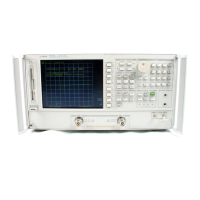manually, although the procedures are more time
consuming.
offsets the frequency of both the
A3
YIG oscillator
and the A3 cavity oscillator to avoid spurs which
_
_
_
..,. ,.
. . . .
....:.:.:
cannot
othe&e
be
filtered
out.
~~~~~~~i:~~~.;
allows e
xamination
of these spurs for service.
enables and disables the analog bus, described
below. Use it with the analog in menu,
(a description of this menu follows).
Analog Bus
Description of the
Analog
Bus
The analog bus is a single multiplexed line that networks 31 nodes within the
instrument.
It can be controlled from the front panel, or through HP-IB, to
make voltage and frequency measurements just like a voltmeter, oscilloscope, or
frequency counter. The next few paragraphs provide general information about
the structure and operation of the analog bus See “Analog Bus Nodes,
n
for a
description of each individual node. Refer to the “Overall Block Diagram,” in
the “Start Troubleshooting” chapter, to see where the nodes are located in the
instrument.
The analog bus consists of a source section and a receiver section. The source
can be the following:
n
any one of the 31 nodes described in “Analog Bus Nodes”
n
the
Al4
fractional-N VCO
n
the
Al4
fractional-N VCO divided down to 100
kHz
The receiver portion can be the following:
n
the main ADC
n
the frequency counter
When analog bus traces are displayed, frequency is the x-axis. For a linear
x-axis in time, switch to CW time mode (or sweep a single band).
1
O-22
Service Key Menus and Error Messages

